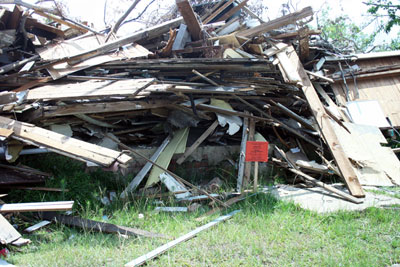

While Tuscaloosa, Alabama, an ICC Governmental Member, continues to recover from a devastating EF-4 tornado that struck the city April 27—Chief Building Official Alan Boswell reported that 70 percent of the debris had been removed as of June 29—local officials are already eyeing the future and the city’s rebuilding process. “There’s some good coming from the bad, there’s no doubt about that,” Boswell said.
“If there is anything good about this particular tornado, from a structural standpoint, it couldn’t have picked a better path,” Boswell told an ICC contingent that included Board of Directors President Jimmy Brothers and CEO Richard P. Weiland during a tour of the storm damages. “It cleaned up a lot of problems we had such as older homes being used as office spaces.”
“Building Officials and other responders are critical to the recovery of our communities and it is important that these officials be in the best position to help,” Weiland said. “Our heartfelt sympathies go out to our Member jurisdictions that have been affected by this year’s outbreak of storms and disasters. We are committed to helping them build back safer and smarter communities.”
 |
|
| Inspectors used a three-part rating system (red—unsafe; yellow—restricted use; green—safe) to assess structures damaged by the storm. |
In addition to rebuilding to the 2009 International Codes, Boswell said city officials also are considering the use of storm shelters or safe rooms in public use facilities and businesses and multi-housing structures. “Occupants of commercial apartment buildings don’t have anywhere to go,” Boswell said. “In public facilities and businesses, my own personal opinion is, if we’ve spent time and money on sprinklers, means of egress and other code issues, why not protect me during a storm?”
Boswell credited the city ’s existing emergency operations plan for response to the tornado—even though the emergency management center was destroyed by the storm and some officials were forced to temporarily use space at Bryant-Denny Stadium at the University of Alabama before moving operations to the Alabama Fire College facility. “We’ve come a long way over the past two or three years,” Boswell said. “I was ready to go the next day to perform rapid assessments.”
Using computer software to track inspections and a three-part rating system (red —unsafe; yellow—restricted use; green—safe), Boswell said inspectors performed damage assessments on more than 5,000 structures over a two-week period following the storm. More than 2,000 structures were deemed unsafe or destroyed. “FEMA was impressed with what we had done,” Boswell said. “We saved them a lot of time.”
Even so, Boswell said there were immense challenges with the aftermath of the devastating tornado. “Not ever doing this, a lot of it was shooting from the hip, to be honest with you,” he said. “We pretty much had an idea, and then asked, ‘What do you think you need to do?”
Boswell and other Building Officials impacted by this year ’s tornado activities will be part of an ICC event to focus on lessons learned and intergovernmental cooperation that will be announced in the near future.
